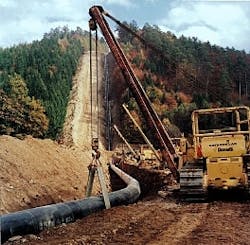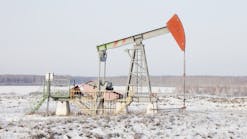Work progresses on the looping of the Trans Austria gas pipeline that moves Russian natural gas from the Slovakia-Austria border to Italy, Slovenia, and Croatia as well as into and across Austria. - A prefabricated string of longitudinally welded line pipe is lowered in at the Tafelkogel slope, gradient 50%, along the Trans Austria gas line. (Photograph from Europipe GMBH, Ratingen, Germany)
Construction by operator OMV AG of 377 km segment of project began in 2000 with an aim of increasing capacity to 33 billion cu m/year.
Dimensions
For this segment, Europipe GMBH, Ratingen, Germany, manufactured about 170 km of submerged-arc longitudinally welded cold expanded steel pipes in material L 485 MB. The pipe was ordered in 40 in. (1,016 mm) OD, 12.5 mm and 14.6 mm WT; 48 in. (1,220 mm) OD, 25.9 mm WT; 42 in. (1,067 mm) OD, 16 mm WT; and 36 in. (914.4 mm), 17.5 mm WT. Average mill length per joint was 17.7 m.
EUPEC PipeCoatings GMBH, a Europipe subsidiary, provided a 3.7-mm high-density polyethylene coating and a 60-mm epoxy lining as a flow coat.
In addition, Mannesmannröhren Mulheim GMBH, Mulheim, Germany, has manufactured and supplied 133 induction bends from Europipe large-diameter pipes, according to Europipe.
The project is subject to the Austrian Environmental Compatibility Act, says the company, and the three Austrian federal states involved granted construction permits. Distance between the new and original pipeline is typically 7.5-10 m, says Europipe; the new line is being buried with a 1.2 m soil cover.
A special challenge, both technically and ecologically, has been the drilled crossings beneath the Donauauen National Park and the Danube and Fischa rivers.
These operations were completed in November 2000.



